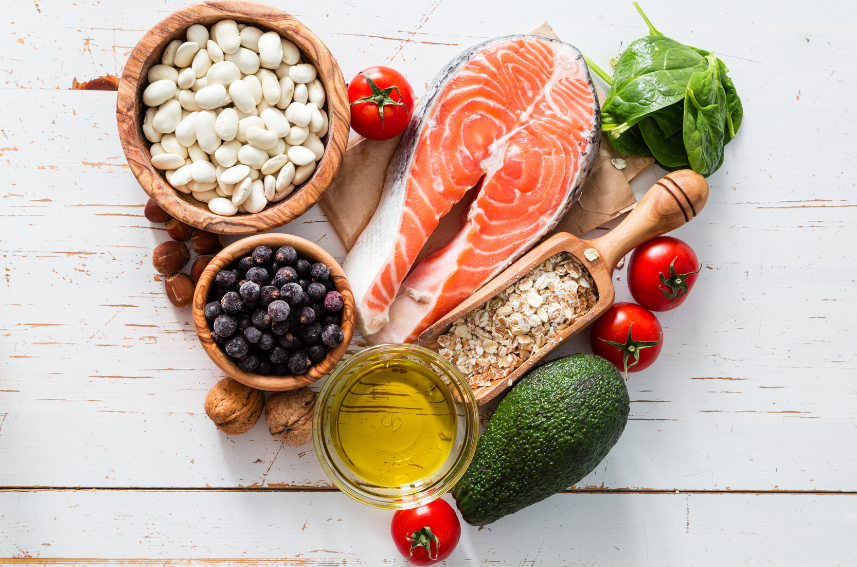
Cholesterol + Heart Health in Women
As we age, estrogen levels drop, negatively impacting cholesterol. Here’s what to know about heart health in women.
It’s American Heart Health Month and a great time to take a closer look at how to keep our hearts healthy and strong as we age.
One of the key indicators of heart health in women is cholesterol levels. Doctors look to the cholesterol panel as a sign of heart health and studies show that an optimized cholesterol panel can significantly reduce the risk of heart disease. As women age, keeping cholesterol optimized gets tricky. In general, as estrogen drops, cholesterol rises.
Let’s dig into exactly what the cholesterol panel looks at and what optimal heart health in women actually means.
Heart Health + Cholesterol
Cholesterol is a waxy substance found in your blood, essential for building cells, producing hormones, used in proper nervous system functioning, and lots more. The cholesterol panel that is tested and discussed at the regular doctors appointments is: Total Cholesterol, LDL levels, HDL level, triglycerides, and sometimes VLDL levels. Then some of those numbers are put into ratios.
Understanding the Cholesterol Panel
- Low-Density Lipoprotein (LDL): LDL is known as the “bad” cholesterol. It carries cholesterol from the liver to the cells throughout the body. When there’s an excess of LDL cholesterol in the bloodstream, it can lead to plaque buildup in the arteries, increasing the risk of heart attack or stroke.
- High-Density Lipoprotein (HDL): HDL is often referred to as “good” cholesterol. It transports cholesterol back to the liver from the cells. By removing cholesterol from the arteries and preventing plaque buildup, HDL helps reduce the risk of heart disease.
Ideally, you want low levels of LDL and high levels of HDL. This balance helps ensure that cholesterol is effectively transported and managed in the body and not building up and causing problems.
- Very Low Density Lipoprotein (VLDL): VLDL lipoproteins are produced by the liver and carry triglycerides through the body via the bloodstream. VLDL is considered a “bad” cholesterol because high levels can contribute to the buildup of plaque in the arteries.
- Triglycerides: Triglycerides are formed when the body converts excess sugars and calories into fat for storage throughout the body.
Aging + Cholesterol in Women
A study published in the Journal of Clinical Endocrinology & Metabolism confirmed that women experience an increase in LDL cholesterol and a decrease in HDL cholesterol during the menopausal transition. That’s not great.
This increase is closely linked to a decrease in estrogen. Greater estrogen levels have a beneficial effect on HDL (good) and lower levels of LDL (bad cholesterol). Estrogen inhibits LDL absorption in the intestines, assisting low LDL.
What to Do For Better Heart Health
Decrease Sugar: The most significant dietary change you can make for heart health is reducing your sugar intake. High sugar consumption is linked to increased triglycerides (Again…excess sugar is converted into triglycerides in the liver. High triglyceride levels raise LDL cholesterol levels and lower HDL cholesterol levels). Tip: Lowering cholesterol is a sugar-lowering exercise and NOT an avoiding healthy fat game.
Increase Fiber: Fiber, particularly soluble fiber, has been shown to lower LDL cholesterol levels. Soluble fiber is the kind found in oats, beans, lentils, fruits and veggies. It binds to cholesterol in the intestines and removes it from the body.
Add Fats: We’re not talking about margarine or Oreos. We’re talking about healthy fats, particularly monounsaturated and some polyunsaturated fats because they help improve cholesterol levels and create greater heart health.
A study conducted by the American Heart Association showed that individuals who consumed a diet rich in monounsaturated fats had better cholesterol levels compared to those who consumed saturated fats. Healthy fats include salmon, trout, fatty fish like mackerel, all nuts and seeds including natural nut butters, avocados and olive oil — try to include more of these in your diet.
Limit Alcohol: Too many drinks can raise triglyceride levels. It’s that simple.
Weight Loss + Weight Maintenance
Losing weight and maintaining a normal weight assists in a normal cholesterol panel. Research has proven that people who lost at least 5% of their weight significantly reduced their levels of LDL, total cholesterol and triglycerides.
Lifestyle Changes for Improved Cholesterol + Heart Health
Exercise: Adding more exercise can help raise HDL cholesterol and lower LDL cholesterol levels. Aim for at least 150 minutes of moderate exercise per week. Strength training/resistance training can also aid in improving overall cholesterol levels (and metabolism). Shoot for two to three days a week.
Maintain a Healthy Weight: Weight loss + management through diet and exercise is important. Excess body weight can negatively affect cholesterol levels.
Summary: If you’re concerned about your heart, or have out of range cholesterol markers, there’s no time like the present to address them with diet and exercise changes.
Need some help? Reach out to Healthy Nest Nutrition and connect with owner and holistic nutritionist Robin Hutchinson for a complimentary 20-minute phone consultation. Let’s see if Healthy Nest programs are right for you.
